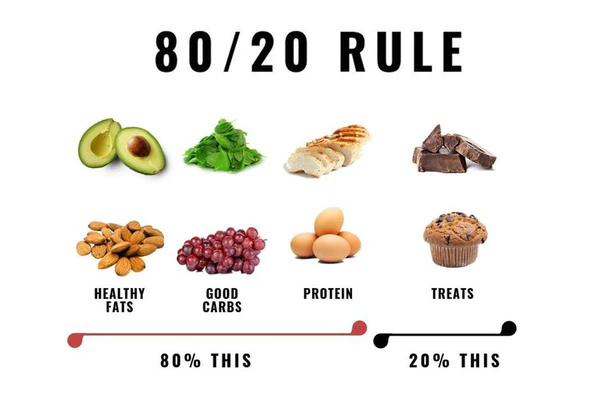We live in an age where wellness is everywhere – in the food we eat, the steps we count, the apps we download, and the guilt we carry for not doing enough. Sometimes, it often feels like a checklist of impossible standards that can lead to burnout, guilt, and an overwhelming sense of failure. The truth is, sustainable wellness doesn’t require perfection. It requires consistency, flexibility, and a realistic approach to health.
Enter the 80/20 Rule :
A timeless principle borrowed from economics and brilliantly adapted for our everyday well-being. It’s not a magic number. It is a mindset. This method encourages a more forgiving and effective way to manage diet, exercise, and rest. It empowers individuals to stay on track without losing joy, spontaneity, or mental peace, ie – three elements often missing in modern wellness narratives.
What Is the 80/20 Rule in Wellness?
The 80/20 rule, originally coined by economist Vilfredo Pareto suggests that 80% of outcomes come from 20% of the inputs. In wellness terms? It’s the ultimate permission slip:
“Be consistent 80% of the time, and you can chill the other 20% guilt-free.”
Eat clean 80% of the week? Bring on that cheesy naan.
Exercise regularly? Great, your couch still loves you.
Sleep like a baby most nights? You’ll survive that occasional midnight binge-watch.
This rule is not about slacking, it is about sustainability. Because guess what? No one sticks to a 100% perfect life (unless they are a robot, although even AI messes up every now and then 😉
Nutrition: Eat to Nourish, Not Punish
One of the easiest places to apply the 80/20 principle is your plate.
The 80%: Focus on whole, nutritious foods that fuel your body.
- Fresh vegetables
- Whole grains
- Lentils, legumes, tofu, paneer
- Healthy fats like nuts, seeds, and cold-pressed oils
- Water, herbal teas, and gut-friendly drinks like buttermilk
But that remaining 20%? That’s your zone. A creamy bowl of kheer. An impulsive choco lava cake. The fries you said you wouldn’t order (but totally did).
Reminder: Eating well isn’t about restriction. It’s about consistency, not perfection. Let go of the “cheat day” guilt. With the 80/20 rule, it becomes part of the plan.
Movement: Discipline Meets Enjoyment
Exercise shouldn’t feel like punishment. It’s a celebration of what your body can do, and it doesn’t always require a gym membership or a military routine.
People think the 80/20 rule in fitness means you can skip the gym four days a week XD. What it actually means is that you stay active 80% of the time in ways that you enjoy!
That includes:
- Dancing like no one’s watching
- Taking the stairs
- Structured workouts (strength training, Pilates, cardio)
- Daily walks (even short ones)
- Signing up for fun movement-based options, like yoga classes
If you are from the City of Pearls, you’re in luck! Yoga classes in Hyderabad offer a wide range of options, from traditional Hatha to modern flow styles. Whether you’re a beginner or a seasoned yogi, there’s a class to fit your pace and purpose. The beauty of yoga lies in its dual power to energize and calm, a perfect anchor for the 80/20 lifestyle.
Rest & Recovery: The Silent Pillar
Many of us over-prioritize productivity while ignoring the most essential aspect of health: rest. Sleep deprivation, constant stimulation and lack of downtime can sabotage even the best diet or exercise routine.
Here’s how to get your 80% of rest right:
- Sleep hygiene : Think cool rooms, dark curtains, and no phones in bed (no, not even for “just one Reel”). Get 7–9 hours of quality sleep
- Mental rest: Try meditation, breathwork, or even journaling
- Physical rest: Rest days are super essential for recovery
The 20%: Yes, there will be deadlines, social obligations, and the occasional 2 AM Netflix trap. That’s okay, as long as it’s not the norm. Let your baseline be peace, not panic.
The Psychological Edge: Why This Works
The 80/20 rule gives you room to live. It’s not a loophole. You’re not “failing” if you don’t meditate every day, or if you skipped leg day last week. You are simply human, and being human includes cravings, laziness, and Netflix marathons.
But it also includes growth, strength, and laughter in downward dog during your yoga class. By allowing yourself a buffer, you reduce the stress of trying to be perfect and instead focus on being persistent. That shift from pressure to permission is often what turns short-term wellness attempts into long-term lifestyle changes.
Final words
Eat real food 80% of the time. Indulge guilt-free 20% of the time. Move with joy most days. Rest like it matters (because it does). Sleep well. Laugh often. Let go of perfection. Join a yoga class (especially if you’re in Hyderabad 😉
And most importantly — be kind to yourself!










